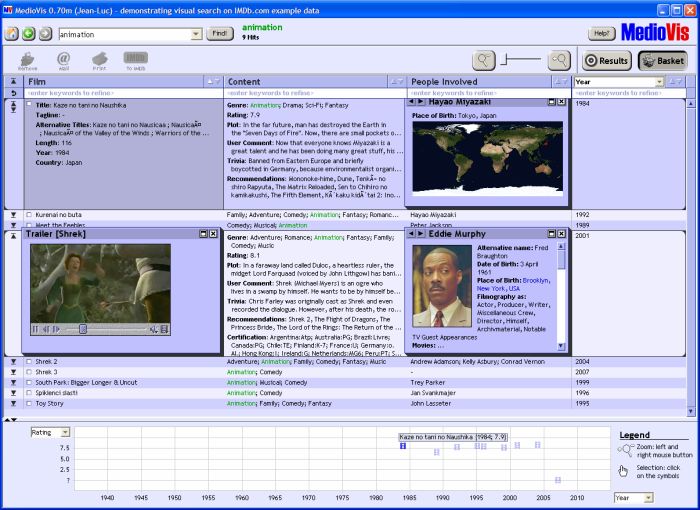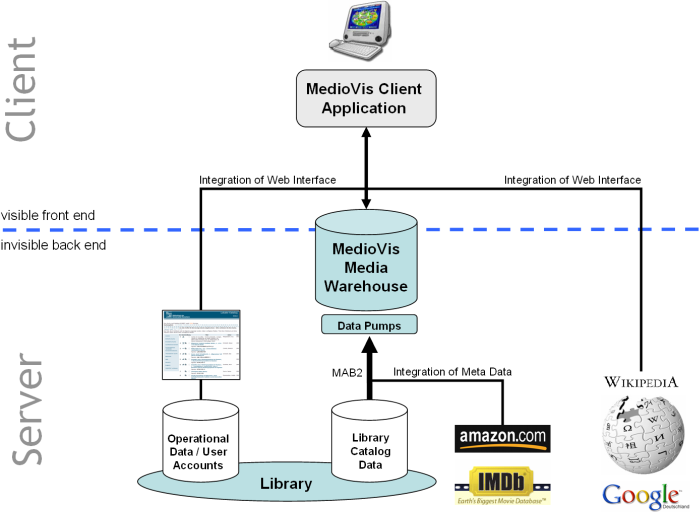MedioVis
Visual Interface for Searching and Exploring Multimedia Libraries

Duration
23.11.2005 - 22.05.2008
Members
Hans-Christian Jetter, Christian Grün, Sebastian Rexhausen, Mischa Demarmels, Carsten Marx, Jens Gerken, Werner König, Joachim Bieg, Oliver Runge, Stephan Huber
Description
Please visit the MedioVis 2.0 website for the most recent information.

MedioVis Demo Video
External Page
To view this content (source: www.xyz.de ), please click on Accept. We would like to point out that by accepting this iframe, data could be transmitted to third parties or cookies may be stored.
You can find more information on our privacy policy .
MedioVis in a Nutshell
- Visual search and exploration in digital libraries, catalogues or multimedia databases
- User-centred document- and knowledge retrieval
- Multiple application scenarios: libraries, e-commerce, desktop or intranet search, video-on-demand, media asset management, ...
- Visual interface and new zoomable user interface components (e.g. the HyperGrid) for easily accessing multimedia metadata or fulltext (e.g. JPG, PDF, AVI, MP3, ...) without losing visual context
- MedioVis explores innovative solutions for multimedia document storage and retrieval in cooperation with the AG DBIS (Prof. Scholl, University of Konstanz) and the BaseX project
External Page
To view this content (source: www.xyz.de ), please click on Accept. We would like to point out that by accepting this iframe, data could be transmitted to third parties or cookies may be stored.
You can find more information on our privacy policy .
Introduction


MedioVis is a research project of the workgroup Human-Computer Interaction at the Department of Computer- and Information Science of the University of Konstanz, Germany.
MedioVis is concerned with the user-centred development of next generation visual information seeking systems for novice and non-expert users. A central design goal of the MedioVis interface is to offer interaction focussed on supporting realistic human search behaviour: Not only analytical queries but also browsing-oriented strategies shall be supported, for example by allowing a quick overview, filtering, zooming into details, and "surfing" within the search results.
Additional multimedia metadata will be automatically collected from Web ressources to support the user's decision for or against contained objects. For example the plain-text meta data of a library catalogue can be enhanced with multimedia content like book covers, film trailers, plot summaries, biographies or sound files, which are gathered from available data sources on the Web. Therefore MedioVis functions as an integrative visual interface to multiple heterogeneous databases, which offers a remarkable added value compared to conventional systems.
To offer a highly usable interface to this complex and heterogeneous information space, different visualizations, filters and interaction concepts are integrated into MedioVis (e.g. the zoomable table visualization HyperGrid or zoomable scatter plots).
Fully operational Java prototypes of MedioVis are currently field tested in different application domains, such as searching and exploring the Mediothek of the library of the University of Konstanz. This part of the library contains numerous VHS, DVD, CD-ROM, CDDA, ... media.
MedioVis aims at assisting the user in all phases of the search process for such documents - starting from the first search terms and ending in the selection of the individual document (illustration 1). The necessary steps after the search process (e.g. locating or ordering the physical document within the library or the usage of playback devices) are supported through context-sensitive additional information like individualized floor plans or usage instructions (illustration 2 - bottom right).
To measure the extent in which MedioVis succeeds in supporting the user needs, a logging technology based on our project DROID is integrated into the system, which allows a long-term collection of usability relevant interaction data and user feedback in a central usability warehouse, where it can be processed and analyzed.
Although the MedioVis project is currently focussed on the application in the Mediothek Konstanz, MedioVis is designed to be quickly adapted to other use cases and information spaces quickly. As a Java application or applet it can be integrated into websites or intranet pages as easily, offering new possibilities in the field of e-commerce, document management or content management.
Feel free to download the MedioVis Demo DVD or try the online version of MedioVis for testing purposes. Please do not hesistate to contact us for any questions or comments concerning the project.
Kind regards,
the MedioVis development team
Research Topics
A brief description of research issues addressed by MedioVis are provided in the following paragraphs:
- HyperGrid - with "HyperGrid" MedioVis contains an innovative concept of interaction and visualization which combines the rich functionality of the traditional table with the possibilities of a visual drill down into the depth of information space. Based on the EU-funded projects INSYDER (Reiterer et al. 2000) and INVISIP (Reiterer et al. 2003) a new concept for a direct manipulation (e.g. by changing cell size) of the level of detail for single attributes is introduced. Inspired by DateLens (Bederson et al. 2004) the additional information on attributes is displayed directly at their location in the table and is completely integrated into the table model (illustration 2). Every table cell can be starting point of a such a drill down process. This fusion of semantic zooming and focus-and-context technology enables the user to quickly receive detailled information of different modalitites about a table element without losing it's context within the table. HyperGrid is applicable in numerous application contexts ranging from museums over video-archives to e-commerce applications. The economic usage of display space allows new possibilities in the field of mobile devices (PDA, mobile phone, Tablet PC) as well. These possibilites will be illustrated in the course of the project.

- Dynamic Queries, Filtering - During the exploration of large data sets the amount of displayed data must not exceed a manageable size. For this reason there exist numerous dynamic query and filter concepts (Shneiderman 1994) to reduce amount of data. These shall be implemented, enhanced and combined in MedioVis's tables and visualizations. The challenge lies in synchronizing multiple filter functions with the multiple data views (e.g. HyperGrid, scatterplot) in a user-oriented manner.
- DROID - with Dynamic Remote Operation Incident Detection MedioVis introduces a new technology for logging user interaction for usability evaluation in development and post-deployment-phase (Jetter 2003). All relevant interaction is detected and logged by software components which can be integrated easily in every application by a flexible software framework. This highly cost-effective method to collect precise usage data without intense analysis of video material offers whole new possibilities for mid- and long-term observation of learning processes and allows location- and time-independent remote usability testing. Additional information about DROID can be found on a seperate project description.
- Integration of Heterogeneous Multimedia Data Sources - Regarding scientific recherche current meta data standards for libraries do not provide sufficient information about multimedia documents for the user. Through aggregation of meta data of various standards and modalities from different sources MedioVis can multiply the amount of searchable information. This offers an remarkable added value compared to conventional search systems. However this integration puts challenges to the employed data models and user interfaces and demands the access to similiar objects in different databases without common keys. At this point the experience of our workgroup in the field of Data Warehouse solutions (e.g. Executive Information Systems for OLAP-databases) is essential (Reiterer et al. 2000).
- Mobile MedioVis - Based on the research work and publications of the Mobile Inf Viz project and bachelor theses we now explore ways to make MedioVis available on small displays of mobile devices. The aim is to develop methods of information presentation and new location based services suitable for mobile access to digital and real word libraries.
Data Storage, Data Enrichment, Integration
MedioVis stores core data (e.g. bibliographic catalogs) and enriches this data with additional multimedia metadata which is automatically collected from Web resources (e.g. movie databases or online stores).
The core and the enriched data is stored in the MedioVis Media Warehouse. This database works independently from operative systems in the library and therefore MedioVis can be easily adapted to other use-cases or scenarios (e.g. document management, e-commerce catalogs).
Additonal functionality (e.g. account administration, service functions, web services like Google Maps) which requires real-time access to the operative system, can be provided by integrating external Web interfaces into the MedioVis visualizations.



MedioVis is published under the GPL v3. You can find the development page at SourceForge.
Literature
- Bederson, B.B., Clamage, A.D., Czerwinski, M.P., Robertson, G.R. 2004: DateLens: A Fisheye Calendar Interface for PDAs. In: ACM Transactions on Computer Human Interaction, Vol. 11, No. 1, March 2004, Pages 90-119.
- Feteke, J.-D., Plaisant C. 2003: Interactive Information Visualization of a Million Items. In: Bederson B., Shneiderman B. (Hrsg.): The Craft of Information Visualization - Readings and Reflections, Morgan Kaufman, 2003, pp. 279-286
- Jetter, H.-C. 2003: Usability Evaluation im Rahmen von INVISIP, Bachelor-Arbeit, Universität Konstanz, 2003, http://www.ub.uni-konstanz.de/kops/volltexte/2003/1046/pdf/jetter.pdf
- Mann, Thomas M. 2002: Visualization of Search Results from the World Wide Web, Dissertation, Universität Konstanz, 2002, http://www.ub.uni-konstanz.de/kops/volltexte/2002/751/
- Mußler, Gabriela 2002: Retrieving Business Information from the WWW. Dissertation, Universität Konstanz, 2002, http://www.ub.uni-konstanz.de/kops/volltexte/2002/844/
- Reiterer, H.; Mußler, G.; Mann, T.; Handschuh, S. 2000: INSYDER - An Information Assistant for Business Intelligence. In: Proceedings of the 23 Annual International ACM SIGIR 2000 Conference on Research and Development in Information Retrieval. ACM press, 2000, Pages 112-119.
- Reiterer H., Mann T., Mußler G., Bleimann U. 2000a: Visualisierung von entscheidungsrelevanten Daten für das Management, in: HMD, Praxis der Wirtschaftsinformatik, Heft 212 04/2000, S.71-83
- Reiterer H., Limbach T., Müller F., Klein P., Jetter C. 2003: Ein visueller Metadaten Browser für die explorative Erkundung großer Datenmengen. In: Ziegler J., Szwillus G. (Hrsg.): Mensch & Computer 2003, Teubner, Stuttgart, Seiten 165-176.
- Shneiderman B. 1994: Dynamic Queries for Visual Information Seeking. IEEE Software, 11(6), 1994, Pages 70-77.
- Turo D. 2004: Hierarchical Visualization with Treemaps: Making Sense of Pro Basketball Data. In: Bederson B., Shneiderman B. (Hrsg.): The Craft of Information Visualization" Readings and Reflections, Morgan Kaufman, 2003, pp. 237-238
Publication list
